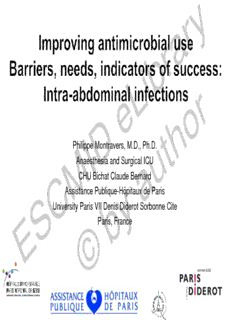
Philippe Montravers, MD, Ph.D. Anaesthesia and Surgical ICU CHU Bichat Claude Bernard ... PDF
Preview Philippe Montravers, MD, Ph.D. Anaesthesia and Surgical ICU CHU Bichat Claude Bernard ...
y r a r b i L r e o h D t I u Philippe Montravers, M.D., Ph.D. M a Anaesthesia and Surgical ICU C CHU Bichat Claude Bernard y Assistance Publique-Hôpitaux de Paris S b University Paris VII Denis Diderot Sorbonne Cite E Paris, France © cIAI, complicated intra- abdominal infection; ICU, intensive care unit. y r a r b i L Speaker for Astellas, Astra Zeneca, Basilea, Cubist, r e Gilead, MSD, The Medicines Company and Pfizoer h D t Advisory board membership for Astellas, Astra Zeneca, I u M Cubist, MSD, Parexel, Tetraphase, The Medicines a Company and Pfizer C y S b E © y r (ASP) a r b i L We suggest: r e o • ASPs develop facility-specific clinical practice guidelines coupled with a h D dissemination and implementation strategy t • ASPs implement interventIions to improve antibioutic use and clinical M outcomes that target patients with specific infectious diseases syndromes a C • We recommend that hospitals implement PK monitoring y S • Antibiotic stewardship interventionsb designed to reduce the use of antibiotics E © • The use of strategies (eg, stop orders) to encourage prescribers to perform routine review of an tibiotic regimens to improve antibiotic prescribing • ASPs implement guidelines and strategies to reduce antibiotic therapy to the shortest effective duration Barlam TF et al. Clinical Infectious Diseases® 2016;62(10):e51–e77 y r a r b Empirical antibiotic therapy i L r e o Monitoring of anti-infective agents h D t I u De-escalation and definitive therapy M a C y Use of biomarkers S b E © Duration of anti-infective therapy y r a r b Empirical antibiotic therapy i L r e o Monitoring of anti-infective agents h D t I u De-escalation anM d definitive therapy a C y Use of biomarkers S b E © Duration of anti-infective therapy y r a r b Primary peritonitis i L Diffuse bacterial infection (usually single organism) without loss of integrity of the r gastrointestinal tract, typically seen in cirrhoetic patients with ascites or patients with o an indwelling peritoneal dialysis catheter h D Secondary peritonitis t Acute peritoneal inflammatIion resulting from loss of integruity of the gastrointestinal M tract. Depending on the underlying pathology, it can be infectious or sterile a Community-acquired IAIs C Healthcare-associated IAIs y Hospital-acquired IAIs S b Nosocomial E Postoperative © Tertiary peritonitis Recurrent infection of the peritoneal cavity that occurs >48 hours after apparently successful and adequate surgical source control of secondary peritonitis IAI, intra-abdominal infection. WeigeltJ. ClevClinJ Med2007;74 (Suppl4):S29–37. y r Key micro-organisms of the bowel flora a r b Cocci i Bacterial anaerobic flora (Streptococci spp, Peptostreptococci spp…) L Bacilli r e (Bacteroides spp, Clostridium spp, Fusobacterium spp, …) o h D Streptococci Bacterial aerobic flora t IEnterococci u (E. faecalis, E. faecium, …) Gram-positive M Staphylococci (S.a aureus) C y Enterobacteriaceae S b (E coli, Klebsiellaspp, Enterobacter spp, Proteus spp, Serratia spp…) Gram-negative bacilli Non-fermenting Gram-negative bacilli E © (Pseudomonas spp, Acinetobacter spp) Yeasts Fungal flora (C. albicans, C. glabrata,…) Other fungi Adapted from: SolomkinJ, et al. ClinInfect Dis 2010;50:133–64; 2. SartelliM, et al. World J EmergSurg2013;8:3; 3. Montravers P, et al. AnaesthCritCare Pain Med2015;34:117–30; 4. EckmannC. Chirurg2016;87:26–33; 5. SartelliM, et al. World J EmergSurg2016;11:33. y r a r b A retrospective analysis on the Surviving Sepsis Ciampaign database to evaluate L the relationship between timing of antibiotic administration r e and mortality o 165 ICUs in Europe, the United State s, and South America h D A total of 28,150 patients with severe sepsis and septic shock, were evaluated t I u 30.0 M a 25.0 ) C % ( s y t 20.0 n e it S b a p f 15.0 o n E PPnneeuummonoinesias o itr 10.0 © PPéerritiotoninteitsis o p o r P 5.0 0.0 00- à1 1 H Hr 11- à2 2 H Hr 22 à- 33 HHr 33 à- 44 H Hr 44 à- 55 HHr 55- à6 6 HHr >> 66 HHr Délai de l’antibiothérapie (heures) Antibiotic timing (Hr) Ferrer R, et al. CritCare Med 2014;42:1749–55. y r a r b Delayed in first antibiotic administration associated with increased i in-hospital mortality L Linear increase in the risk of mortality for each hour delay r e o Adjusted hospital mortality odds ratio and probability of mortality for time to antibiotics based on a h D generalised estimating equation population averaged logistic regression model t 2 I u Odds ratio D deéacthèsrate M 1.9 a 1.8 33.1 32.3 C 1.7 o y 28.8 27.9 ita 1.6 25.9 27.0 S r 24.6 b s 1.5 d d E O 1.4 © 1.3 1.2 1.1 1 00 à- 11 HHr 11 -à 22 HHr 22 -à 33 HHr 33- à4 4 H Hr 44 -à5 5 HHr 55- à6 6 HHr >> 66 HHr DAénlatii bdieo ttricai tteimmienngt ((hHeur)r e s ) Ferrer R, et al. CritCare Med 2014;42:1749–55. y r a r b Retrospective study i Three countries L 5,715 patients with septic shock Inappropriate r e Appropriate o n p value h D Pulmonary infection 1381 <.0001 t I u IAI 1041 <.0001 M a 0 20 40 60 80 1 10 100 C Survival ( %) Odds ratio y S b Inappropriate AB % E 35 © 30 25 20 15 10 5 0 Bowel perforation/peritonitis Postoperative bowel Intra-abdominal abscess perforation/anastomotic dehiscence Kumar A, et al. Chest 2009;136:1237–48.
Description: